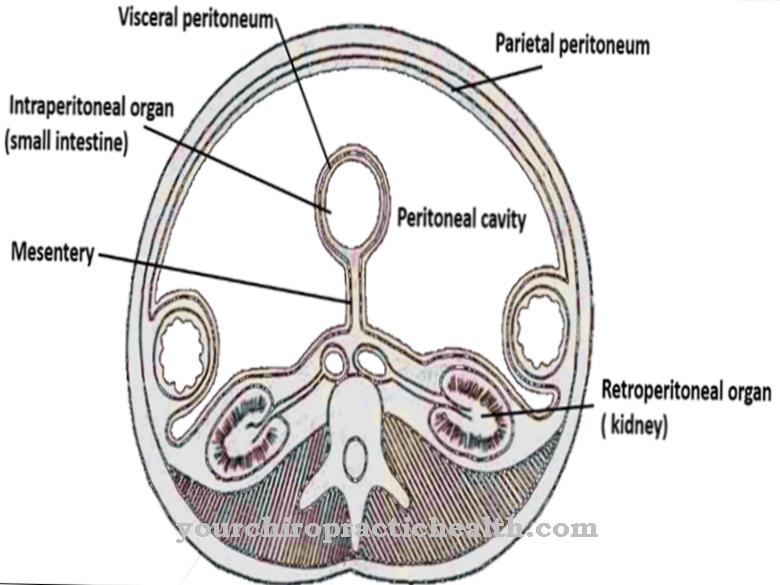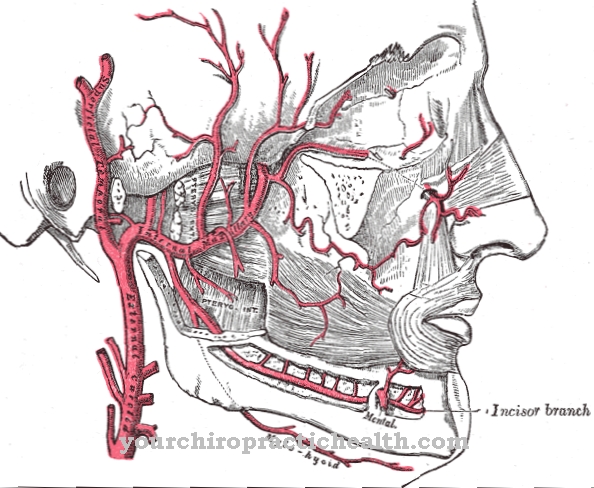Of the Ophthalmic nerve is the branch of the eye of the trigeminal nerve and as such is involved in trigeminal perception. Due to its location in the human head, it primarily absorbs sensory stimuli from the eye region. Functional restrictions can be the result of various neurological and inflammatory diseases.
What is the ophthalmic nerve?
As part of the larger trigeminal nerve, the ophthalmic nerve is one of three branches and, in turn, branches further into smaller nerves. Alternatively, medicine also knows it by the trivial name Eye branch: With the help of numerous branches, the ophthalmic nerve collects sensory signals from the eye area and transmits them to relevant processing centers in the brain and spinal cord.
While other cranial nerves only transmit stimuli of a certain modality (seeing, hearing, smelling, etc.), the fibers of the ophthalmic nerve are generally somatosensitive; they are responsible for general body perceptions, including pressure and pain. In the human nervous system, pain is partly due to very strong stimulation or inadequate stimulation of other sensory cells. In addition, there are specific pain receptors, which medicine also calls nozi receptors. In addition to pressure and temperature, free nerve endings also register chemical substances that are potentially harmful.
Anatomy & structure
The ophthalmic nerve divides into different branches and in this way helps to cover a larger area. The four branches of the ophthalmic nerve also branch out into finer nerves. The Ramus tentorius or Ramus meningeus recurrens connects to the dura mater in the cranial cavity.
The second branch of the ophthalmic nerve is the frontal nerve; it leads inside past the eye muscles to the eye socket. The structure of the frontal nerve is divided into two parts and consists of the supraorbital nerve ("nerve above the eye socket") and the supratrochlear nerve ("nerve above the cartilage"). The lacrimal nerve is located next to the external eye muscles. The fourth and last branch is represented by the nasal lid nerve (Nervus nasociliaris) with connections to the middle eye, conjunctiva and cornea as well as to the tear ducts and nasal cavity. The nasociliary nerve does not run in one cord either, but separates into the ethmoid nerve, infratrochlear nerve and long ciliary nerve.
Function & tasks
The task of the ophthalmic nerve is to transmit and bring together signals. He does not have his own sensory cells and is not in direct contact with them, which is why people usually do not consciously perceive their function. Exceptions are unpleasant temperature, pain and pressure stimuli that can run through the ophthalmic nerve.
The signal transmission within the nerve takes place mainly with the help of electrical transmission. To do this, the nerve cell generates an electrical impulse that travels as an action potential over the found-like end of the neuron. The nerve fibers or axons of the cells in the ophthalmic nerve are longer than those of most nerve cells; the nerve is therefore only dependent on a few connections.
Different branches of the ophthalmic nerve perform different tasks in this context. The Ramus tentorius innervates the dura mater, one of the meninges; Irritation primarily causes pain and thereby warns the body of excessive pressure on the skull, which will damage the sensitive part of the body.
The frontal nerve, with its two branches, the supraorbital nerve and the supratrochlear nerve, connects the eyelid and the region to the nose to the sensory nervous system. The supraorbital nerve runs at the upper edge of the eye socket just below the skin and forms the first trigeminal pressure point there. With a total of three trigeminal pressure points on each half of the face, doctors can determine whether and, if so, where there are lesions or functional limitations of the trigeminal nerve.
The lacrimal nerve has two important functions: Its sympathetic and parasympathetic nerve fibers give the lacrimal gland the signal to secrete fluid. The command comes from the spinal cord. In addition, the tear nerve receives sensory information and forwards it to the brain. Various tissues are attached to the nasociliary nerve; it absorbs sensory stimuli from the eye membranes as well as the tear ducts and nasal cavity.
Diseases
Numerous nerve diseases can affect the ophthalmic nerve directly or indirectly. Those affected feel the consequences either as a reduced sensory system in the affected regions or they suffer from (often painful) perceptions that arise in the nervous system even though there is no triggering stimulus.
Peripheral and central lesions can restrict or prevent the ophthalmic nerve from functioning properly. A peripheral lesion is localized on the nerve itself and can occur, for example, as a result of an injury. This clinical picture manifests itself symptomatically as a lack of sensitivity in the affected facial area; In the case of the ophthalmic nerve, those affected no longer perceive general sensory stimuli from the eye region. If only individual branches of the ophthalmic nerve are damaged, the loss of sensors is accordingly limited to smaller areas. On the other hand, central lesions affect larger sections, since in this case the nerve nucleus in the brain stem is damaged.
Tumors in the myelin sheaths are also a possible cause of symptoms. Doctors refer to them as schwannomas and remove and / or irradiate them to treat them. Pressure pain on the first trigeminal pressure point at the top of the eye socket may indicate other causes; Sinusitis, meningitis, increased incranial pressure or intracranial pressure, swellings and other abnormalities can irritate the ophthalmic nerve and trigger a corresponding sensory reaction. In all cases, therapeutic measures depend both on the specific cause and on individual factors.

























.jpg)


